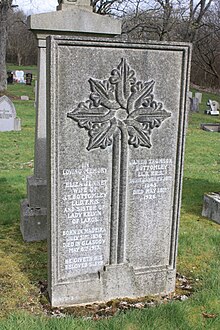James Thomson Bottomley
James Thomson Bottomley | |
|---|---|
| Born | 10 January 1845 Fort Breda,County Down,Ireland |
| Died | 18 May 1926 |
| Nationality | British |
| Alma mater | |
| Occupation | Physicist |
James Thomson BottomleyFRSFRSE(10 January 1845 – 18 May 1926) was an Irish-bornBritishphysicist.
He is noted for his work on thermal radiation and on his creation of 4-figurelogarithmtables, used to convert long multiplication and division calculations to simpler addition and subtraction before the introduction of fast calculators.
Background
[edit]
He was born in Fort Breda,County DowninIreland,on 10 January 1845, the son of William BottomleyJP,a merchant in nearbyBelfast.His mother, Anna Thomson, was the sister ofWilliam Thomson, Lord Kelvin,[1]a connection which served him well throughout his life.
He was educated atQueens College, Belfastand thenTrinity College, Dublin,originally studying natural philosophy and chemistry.[2]
Career
[edit]His first employment was as assistant to scientistThomas AndrewsinBelfast.He then became a Demonstrator atKing's College London,first in chemistry and then in physics.[2] In 1870 he became a Demonstrator in Physics atGlasgow University.In 1875 this was retitled the Arnott and Thomson Demonstrator in Experimental Physics, following a bequest from the widow ofNeil Arnott.
In 1872 his uncleLord Kelvinproposed him as a Fellow of theRoyal Society of Edinburgh,and this was duly accepted. In June 1888 he was elected a Fellow of theRoyal SocietyinLondon.[3]
On 5 February 1896 Bottomley was involved in the first demonstration of x-rays in Scotland. His uncle,Lord Kelvin,had received papers fromRontgen,but being ill passed them to his nephew, Bottomley, to deal with, also passing special equipment needed for the demonstration. Bottomley engagedDr John Macintyrean electrical expert at Glasgow Royal Infirmary to make the demonstration.[4]
In 1899, again with his uncle, the Glasgow engineering firm ofKelvin, Bottomley & Baird(K.B.B) was formed, specialising in gauges and meters but also producing loudspeakers and telephones.[5]He became its chairman in 1908. In 1913 it became a Limited Company. He lived at 13 University Gardens, Glasgow, in this period.[6]
He died inGlasgowon 18 May 1926.[3]His grave stands close to the summit of theWestern Necropolisin Glasgow.
The company of Kelvin, Bottomley and Baird continued until 1947.
Family
[edit]He married twice: firstly to Annie Elizabeth Heap ofManchester;secondly to Eliza Jennet Blandy, daughter of Charles R Blandy ofMadeira.[2]
William Thomson, Lord KelvinandJames Thomsonwere his uncles.
Publications
[edit]- Dynamics: Theoretical Mechanics.1877
- "Electrometersby J. T. Bottomley ".Science Lectures at South Kensington.Vol. I. London: Macmillan & Company. 1878. pp. 216–248.
- On radiation from dull and bright surfaces.London 1887
- On Thermal Radiation in Absolute Measure.1888
- Four figure mathematical tables: comprising logarithmic and trigonometrical tables, and tables of squares, square roots, and reciprocals.
References
[edit]- ^"The University of Glasgow Story; James Thomson Bottomley".University of Glasgow.Retrieved25 January2017.
- ^abc"James Thomson Bottomley; 1845 - 1926".Links.org.Retrieved25 January2017.
- ^ab"Former Fellows of the Royal Society of Edinburgh; (1783-2002)"(PDF).The Royal Society of Edinburgh.Retrieved25 January2017.
- ^"The Fourth Haldane Tait Lecture"(PDF).The Scottish Society of the History of Medicine - Report of Proceedings.1995.Retrieved31 July2021.
- ^"Kelvin, Bottomley and Baird".Grace's Guide to British Industrial History.Retrieved25 January2017.
- ^Glasgow Post Office Directory 1911-12
